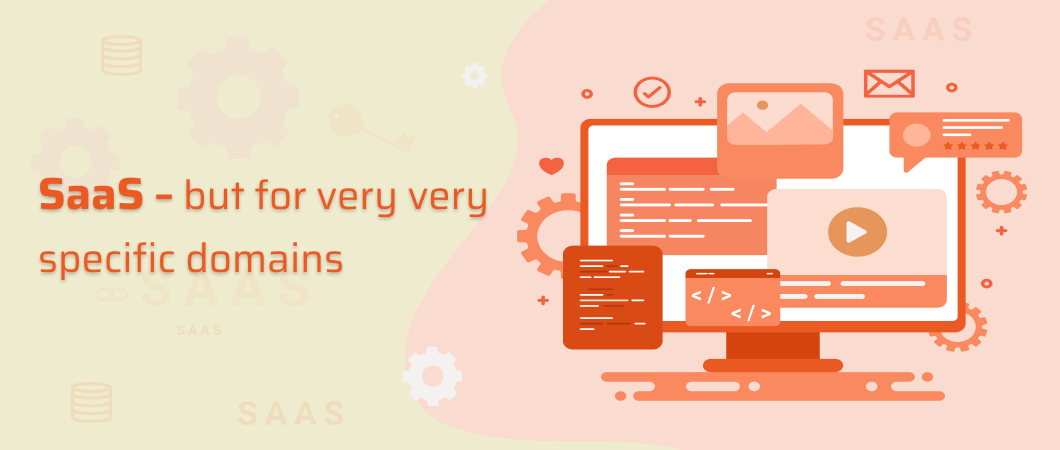In 2022, Gartner predicts that nearly USD 482 billion will be spent on cloud services globally. We have seen how the pandemic accelerated digital adoption worldwide and cloud computing. More specifically SaaS offerings have been in high demand over the past 2 years. From shopping to education, entertainment, healthcare, and finance, nearly every sector witnessed a digital boom spearheaded by their SaaS investments. For many businesses, their SaaS investments led to new revenue channels emerging like an eCommerce platform opening a digital sales channel.
As organizations advance their digital ambitions by leveraging cloud technologies, the SaaS market is evolving too. Up until a few years ago, enterprises leveraged generic SaaS applications that focused on a particular functionality. They had to revamp their own internal processes and workflows to align with the product or platform they chose. Since SaaS platforms had a relatively new presence, this alignment was also considered as a shift to a progressive business process evolution by enterprises as well. But there were cases when businesses already had best practices set up in their internal workflows and processes.
Having to change them to suit the SaaS offering wasn’t an ideal option for such businesses. The alternative was to subscribe to the SaaS product and then invest heavily in customizing and configuring the platform to align with their domain-specific best practices and workflows.
Over time this approach wasn’t turning out to be a lucrative option for enterprises and to mitigate this challenge, the SaaS industry came out with the perfect solution – Vertical SaaS.
Rather than being a generalized software that can be adapted across industries with customization, Vertical SaaS products or platforms are those that have been built exclusively for use in a particular vertical or industry domain. Let us examine 4 reasons why vertical SaaS is emerging as a hot trend in the cloud industry:
What is vertical SaaS?
Vertical SaaS (Software-as-a-Service) refers to a type of cloud-based software that is designed and developed specifically for a particular industry or vertical market. Unlike horizontal SaaS, which provides software solutions that can be applied across various industries, vertical SaaS solutions are tailored to meet the unique needs and requirements of a specific industry or niche.
Vertical SaaS vendors build their software solutions to address industry-specific challenges, workflows, and regulations. These solutions typically offer specialized features, integrations, and customization options that cater to the specific needs of the targeted industry. Some common examples of vertical SaaS sectors include healthcare, finance, real estate, manufacturing, hospitality, and legal services, among others.
Benefits of Vertical SaaS
Specialize and not generalize
From the name and explanation of the concept itself, it is clear that Vertical SaaS solutions differentiate themselves from generic or horizontal SaaS solutions by offering specialized solutions designed for a particular industry vertical. This enables them to cover broader areas of digital transformation within a sector-specific use case. They can offer more pre-built templates or functionalities that are sector or vertical-specific thanks to extensive R&D being deployed in a limited footprint of use. Over the years, learnings from the sector can be applied more constructively into the product roadmap as it only needs to accommodate changes that apply to one specific vertical.
Lower costs
When opting for a larger and more generic SaaS offering, enterprises may have to spend a fortune customizing it to meet their sector-specific needs. Additionally, there will be overheads and costs involved in periodic upgrades or on the addition of features. With Vertical SaaS offerings, customizations needed would be minimal as the vendor would be well versed about the needs of the industry and keep a tab on market trends evolving in the sector. This will significantly reduce the costs and overheads involved in customization efforts.
Faster time to market
As Vertical SaaS products have focused on one specific vertical or business use case, they have more dedicated innovation teams that can help bring newer business functions into their digital ambit faster. For enterprises, there will be minimal time requirement for integrating new workflows or features as there will be inherent support for domain-specific upgrades from the vendor themselves. Implementation timelines can be crashed and the time to value gets accelerated. This creates a win-win situation for all as new features can be brought to the market at a very fast pace than when compared to the situation where a generic SaaS platform was used.
Better ROI
Vertical SaaS products are built keeping in mind a specific set of audiences whose interests and preferences are considered crucial inputs in the software’s ideation and development principles. Hence, when leveraged by enterprises for their customer-facing business models, Vertical SaaS solutions can improve their ROI significantly as they would have a far lower timeline and cost factor for customer acquisition, better personalization for improved customer engagement, and cost-effective scalability owing to the narrower audience focus.
Vertical SaaS products can be a huge competitive differentiator for enterprises as that helps them innovate continuously while controlling costs. But what about startups looking to translate their domain understanding into a Vertical SaaS solution that offers a defined target audience an even more attractive proposition? The answer lies in building your own Vertical SaaS business platform. You may be worried about the unending and complex web of challenges that may come up in this approach from ideation to execution, testing, and deployment. This is where our Build-as-a-Service (BaaS) can come to the rescue. From being your business’s driving force as an execution engine, BaaS enables the easy transformation of business ideas and processes into powerful Vertical SaaS offerings. It enables the rapid development of products that help realize your innovative ideas.
Get in touch with us to know more about building the most lucrative Vertical SaaS business platform for your business with BaaS.
Horizonal SaaS vs Vertical SaaS
Vertical SaaS and Horizontal SaaS differ in terms of the scope and target market of their software solutions. Here are the key differences:
Target Market: Vertical SaaS focuses on specific industries or vertical markets, such as healthcare, finance, or manufacturing. The software solutions are tailored to meet the unique needs and requirements of those industries. Horizontal SaaS, on the other hand, caters to a wide range of industries and markets without specific industry specialization.
Customization: Vertical SaaS solutions are highly customized and optimized for specific industries. They often provide industry-specific features, workflows, and integrations to address the unique challenges faced by businesses in that vertical. Horizontal SaaS, in contrast, offers more general-purpose solutions that are designed to be applicable across different industries. They may provide a broader range of features but lack the industry-specific depth of vertical solutions.
Functionality: Vertical SaaS solutions offer deep functionality and specialized tools that are specific to the targeted industry. They may incorporate industry-specific terminology, compliance regulations, and workflows. Horizontal SaaS solutions provide more general functionality that is applicable across industries, offering a broader range of features that are not industry-specific.
Competition: Vertical SaaS solutions often face less competition within their specific industry since they provide specialized functionality. Horizontal SaaS solutions, on the other hand, face more competition as they compete with a wider range of software providers across different industries.
Forgeahead’s Vertical SaaS Story along with AWS:
Over the last two decades, Forgeahead has also embraced the vertical SaaS model in building highly efficient and scalable Edtech SaaS products.
Having worked with a no. of Edtech clients like NoodleTools, CK12, we gained the industry know how over the years enabling us to consider the trends, challenges of the industry while building Edtech SaaS products for our customers.
Some of the SaaS products we built were cloud native in nature hosted on AWS and some we migrated to AWS to make reduce the overall cost for maintaining the product and to make it more scalable when the need arises. Below are some of the AWS services we used while building these Edtech SaaS Products:



